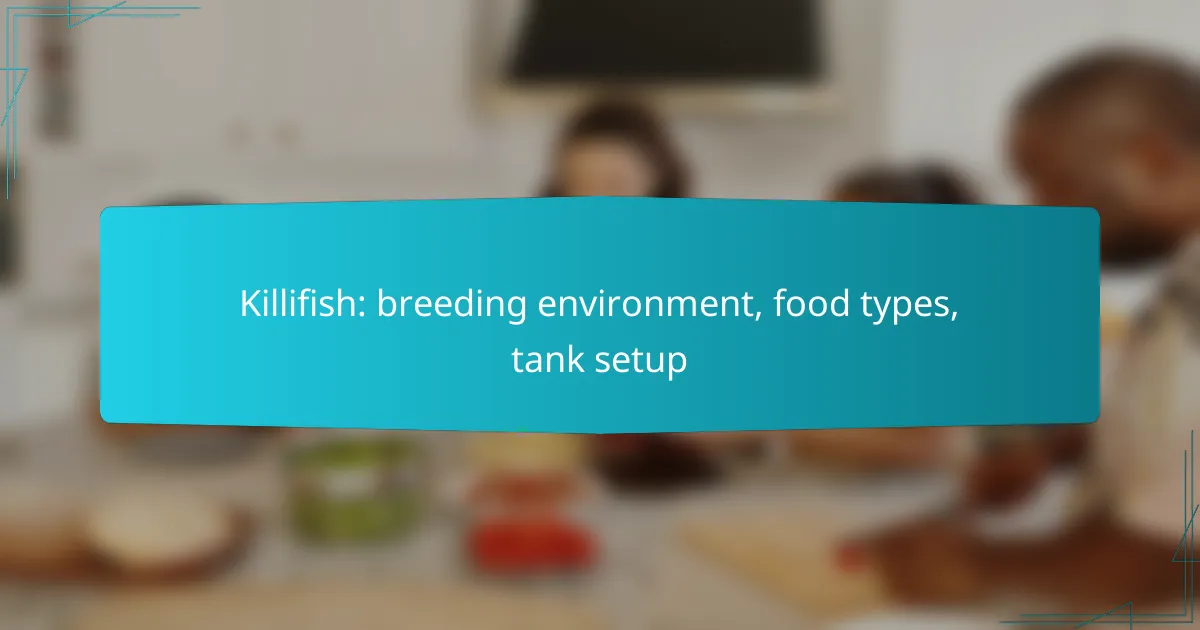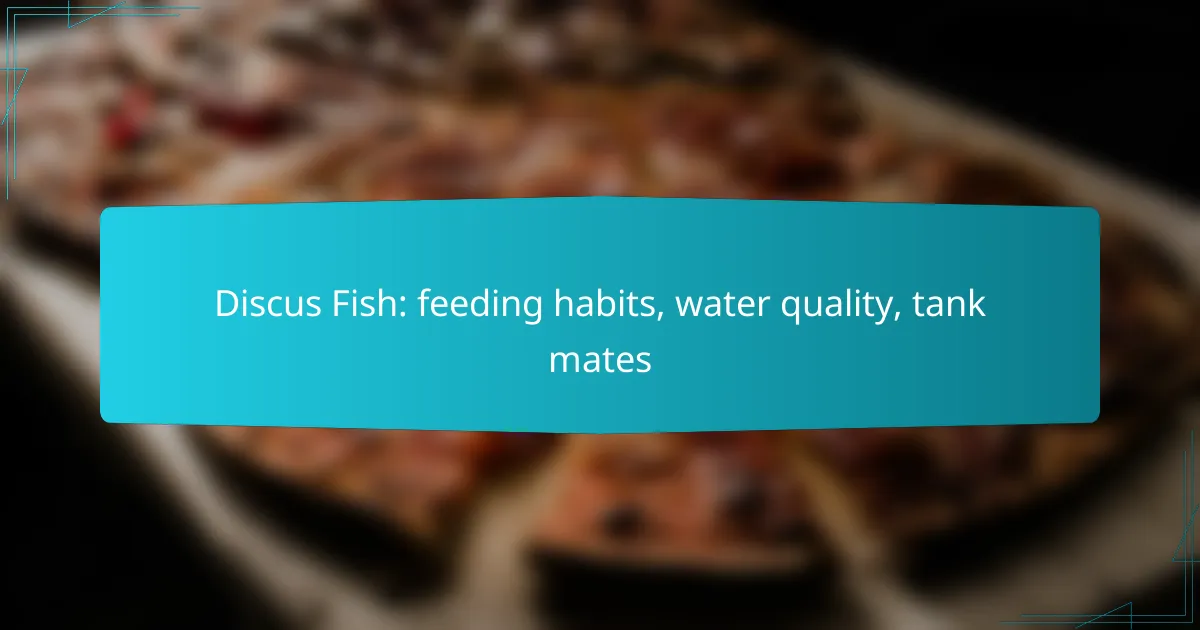To successfully breed Killifish, it is essential to create a suitable environment that includes optimal water conditions, an appropriate tank size, and necessary accessories. A varied diet consisting of live, commercial, and homemade food will promote their health and vibrant colors. Additionally, replicating their natural habitat with ample space and hiding spots is crucial for their well-being.
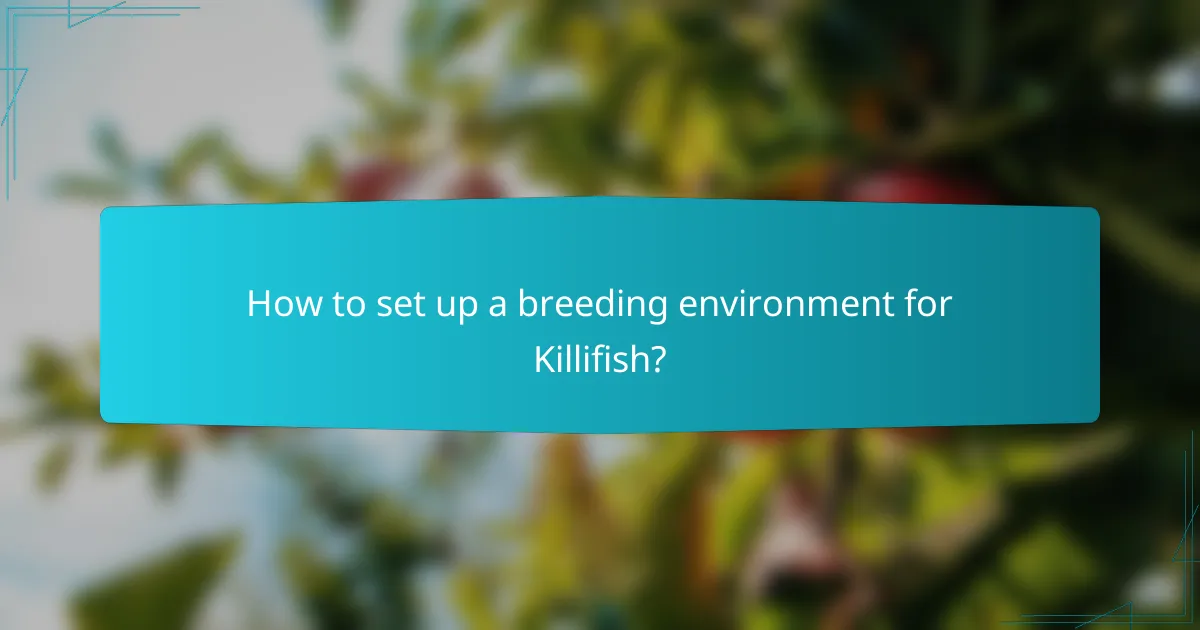
How to set up a breeding environment for Killifish?
Creating a suitable breeding environment for Killifish involves ensuring optimal water conditions, appropriate tank size, and the right accessories. These factors play a crucial role in the health and reproductive success of the fish.
Optimal water parameters
Killifish thrive in slightly acidic to neutral water, with a pH range of 6.5 to 7.5. Maintaining a temperature between 24°C and 28°C is ideal for breeding, as warmer water can stimulate spawning behavior.
Regular water changes are essential to keep the environment clean and stable. Aim for a weekly change of about 20-30% of the tank water to prevent the buildup of harmful substances.
Tank size recommendations
A breeding tank for Killifish should ideally be at least 40 liters (about 10 gallons) to provide ample space for swimming and breeding. Larger tanks can help maintain stable water parameters and reduce stress.
If you plan to breed multiple pairs, consider a tank size of 75 liters (approximately 20 gallons) or more. This allows for better territorial separation and reduces aggression among males.
Breeding tank accessories
Include a spawning mop or fine-leaved plants in the breeding tank, as Killifish prefer to lay their eggs in dense vegetation. These accessories provide hiding spots for the eggs and fry.
A gentle sponge filter is recommended to maintain water quality without creating strong currents that can disturb the eggs. Avoid using gravel or sand substrates, as they can trap debris and harm the delicate eggs.
Best plants for breeding
Java moss, hornwort, and water sprite are excellent choices for breeding Killifish. These plants not only provide cover for the eggs but also help maintain water quality by absorbing excess nutrients.
Ensure the plants are well-established before introducing the fish, as this will create a more inviting environment for spawning. Regularly trim and care for the plants to keep them healthy and promote growth.

What food types are best for Killifish?
Killifish thrive on a varied diet that includes live, commercial, and homemade food options. Providing a balanced mix of these food types ensures optimal health and vibrant colors in your fish.
Live food options
Live food is an excellent choice for Killifish as it stimulates natural hunting behavior and provides essential nutrients. Common live food options include brine shrimp, daphnia, and mosquito larvae. These foods can often be cultured at home, ensuring a fresh supply.
When feeding live food, ensure it is appropriately sized for your Killifish species to prevent choking or stress. It’s also important to source live food from clean environments to avoid introducing diseases into your aquarium.
Commercial food recommendations
High-quality commercial fish flakes or pellets designed for carnivorous fish can be suitable for Killifish. Look for products that list protein-rich ingredients like fish meal or shrimp as the first components. Brands such as Hikari and Omega One are popular among aquarists.
Consider using floating pellets or flakes, as Killifish often feed near the surface. Always check the feeding guidelines on the packaging to avoid overfeeding, which can lead to water quality issues.
Homemade food recipes
Homemade food can be a nutritious supplement for Killifish. A simple recipe involves blending high-protein ingredients like fish, shrimp, and vegetables, then freezing the mixture in small portions. This allows for easy feeding and ensures freshness.
Another option is to create gel food by mixing fish meal with gelatin and water, then allowing it to set. This can be cut into small pieces and fed to your Killifish, providing a varied diet that mimics their natural feeding habits.

How to create an ideal tank setup for Killifish?
Creating an ideal tank setup for Killifish involves providing a spacious environment with appropriate water conditions, hiding spots, and suitable food sources. Focus on replicating their natural habitat to ensure their health and well-being.
Tank layout design
The tank layout for Killifish should include plenty of open swimming space along with plants and decorations that mimic their natural habitat. Use floating plants and dense vegetation to provide shelter and breeding areas. A tank size of at least 20 gallons is recommended to accommodate their active swimming behavior.
Consider using a substrate that allows for planting, such as fine gravel or sand, which can help maintain water quality. Arrange decorations to create different zones within the tank, enabling the fish to explore and establish territories.
Filtration and aeration needs
Killifish thrive in well-filtered and aerated water, so a good filtration system is essential. Use a sponge filter or a gentle canister filter to avoid strong currents that can stress the fish. Aim for a filtration rate of about 5-10 times the tank volume per hour.
Aeration can be achieved through air stones or gentle surface agitation, which helps maintain oxygen levels. Regular water changes of around 20-30% weekly will also support water quality and reduce toxins.
Lighting requirements
Killifish prefer moderate lighting that mimics their natural environment, which is often dappled and shaded. Use LED lights with a timer to provide 10-12 hours of light daily, ensuring a consistent day-night cycle. This not only supports plant growth but also promotes healthy behaviors in the fish.
Be cautious with light intensity; too much light can encourage algae growth and stress the fish. Consider using floating plants to diffuse the light and create a more natural setting within the tank.

What are the common breeding challenges for Killifish?
Common breeding challenges for Killifish include maintaining optimal water quality and ensuring compatibility with other species in the tank. These factors are crucial for successful breeding and the overall health of the fish.
Water quality issues
Water quality is vital for the breeding of Killifish. They thrive in clean, well-filtered water with stable parameters, including a pH between 6.5 and 7.5 and a temperature range of 22-28°C. Regular water changes and monitoring of ammonia, nitrite, and nitrate levels are essential to prevent stress and disease.
To maintain good water quality, consider using a high-quality aquarium filter and performing partial water changes weekly. Test kits can help you keep track of water parameters, ensuring they remain within the ideal range for breeding.
Compatibility with other species
Killifish can be territorial and may not coexist well with all species. When setting up a breeding tank, it is best to avoid aggressive or larger fish that could stress or harm them. Suitable tank mates include small, peaceful species that occupy different levels of the tank.
Consider using a species-only tank for breeding to minimize stress and competition for resources. If you choose to include other species, ensure they are compatible in terms of size, temperament, and environmental needs to promote a harmonious tank environment.
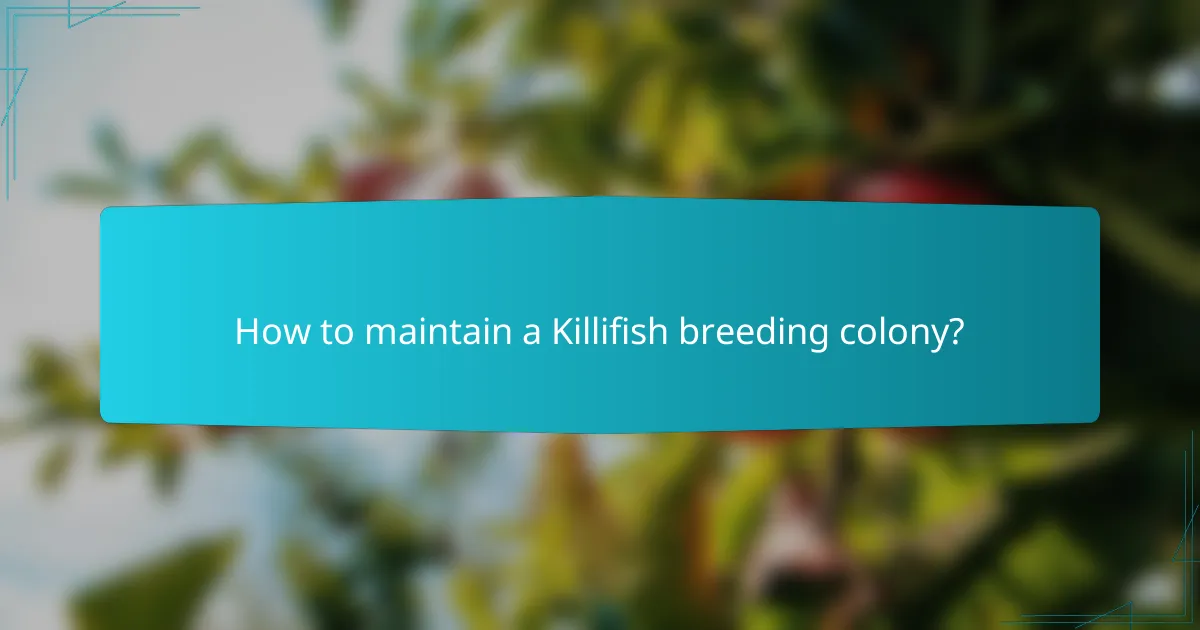
How to maintain a Killifish breeding colony?
Maintaining a Killifish breeding colony involves creating an optimal environment, ensuring regular maintenance, and providing appropriate food. Focus on water quality, tank setup, and feeding schedules to promote healthy breeding and growth.
Regular maintenance routines
Regular maintenance is crucial for a thriving Killifish breeding colony. Perform partial water changes of about 20-30% weekly to maintain water quality and remove toxins. Monitor parameters such as pH, ammonia, nitrite, and nitrate levels to ensure they remain within safe ranges.
Keep the tank clean by removing uneaten food and debris, which can lead to poor water conditions. Regularly check and clean filters to ensure efficient operation, and consider using a sponge filter to provide gentle water flow suitable for fry.
Feeding schedules
Establishing a consistent feeding schedule is essential for the health of your Killifish. Feed adults once or twice a day with high-quality flakes or pellets, supplemented with live or frozen foods like brine shrimp or daphnia to encourage breeding. Fry should be fed several times a day with finely crushed flakes or specialized fry food.
Observe your fish during feeding to ensure they are consuming the food and adjust the quantity as needed to avoid overfeeding. A well-balanced diet will promote growth and reproductive success, so vary food types to provide essential nutrients.
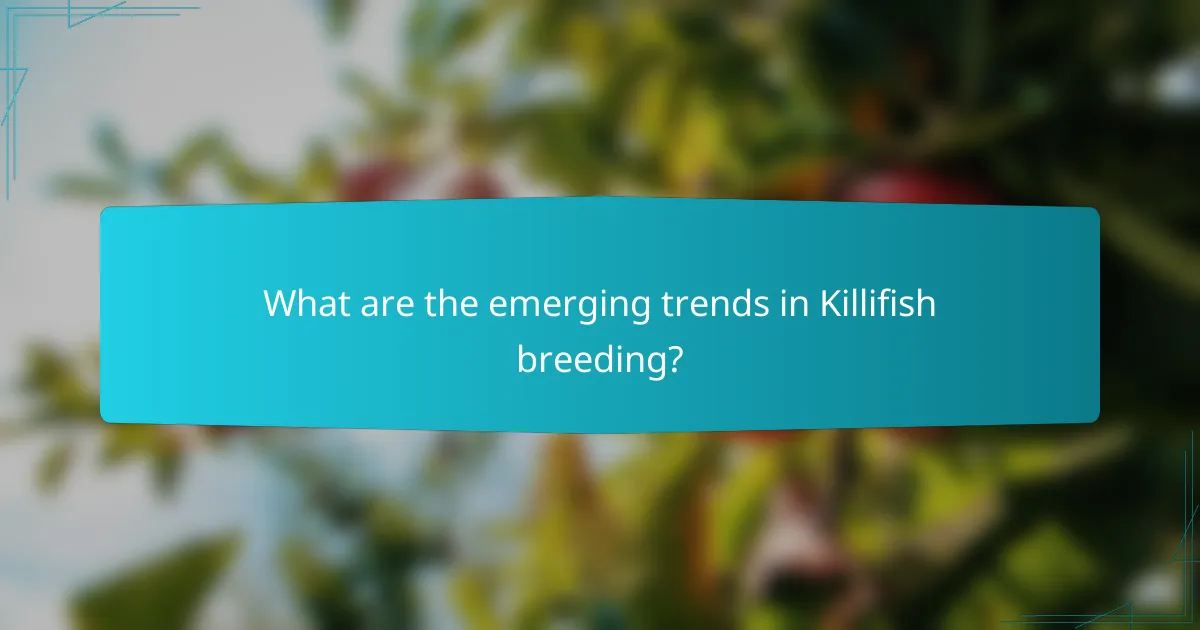
What are the emerging trends in Killifish breeding?
Emerging trends in Killifish breeding focus on enhancing genetic diversity and improving breeding techniques. Breeders are increasingly utilizing selective breeding and advanced tank setups to create optimal environments for spawning and raising fry.
Breeding environment
Creating an ideal breeding environment for Killifish involves replicating their natural habitat. This includes maintaining specific water parameters such as temperature, pH, and hardness, typically ranging from 24-28°C and a pH of 6.5-7.5. Additionally, incorporating plants and spawning substrates can encourage breeding behaviors.
Using a separate breeding tank can minimize stress and increase the chances of successful spawning. A tank size of at least 10 gallons is recommended, with gentle filtration to avoid disturbing eggs and fry. Regular water changes are crucial to maintain water quality during the breeding process.
Food types
Providing a varied diet is essential for the health of Killifish, especially during breeding. High-quality live foods such as brine shrimp, daphnia, and micro worms are excellent choices that stimulate breeding and promote fry growth. Supplementing with high-protein flakes or pellets can also be beneficial.
During the fry stage, feeding them infusoria or finely crushed flakes ensures they receive the necessary nutrients for development. It’s important to feed small amounts multiple times a day to prevent overfeeding and maintain water quality.
Tank setup
A well-planned tank setup is crucial for successful Killifish breeding. Use a substrate that mimics their natural environment, such as fine gravel or sand, and add plenty of hiding spots with plants or decorations. This setup provides security for both adults and fry.
Ensure the tank has a reliable filtration system that maintains water clarity without creating strong currents. A heater may be necessary to maintain the ideal temperature range. Regular monitoring of water parameters will help create a stable environment conducive to breeding.






